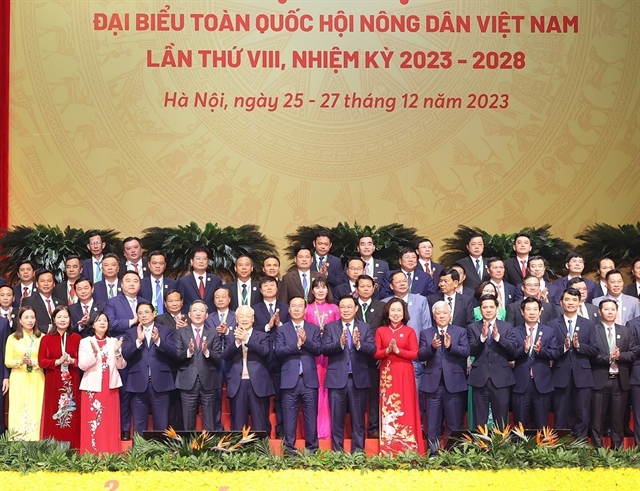Party chief urges farmers to transform agricultural development
Party chief urges farmers to transform agricultural development Viet Nam News


Party General Secretary Nguyễn Phú Trọng emphasizes the transformation of farmers
 |
| Party and State leaders take a group photo with delegates of the eighth National Congress of the VNFU held in Hà Nội on Tuesday. VNA/VNS Photo |
HÀ NỘI — Party General Secretary Nguyễn Phú Trọng emphasized the necessity for farmers to undergo a transformation in both mindset and actions to become the focal points of the agricultural development process.
Given the trends of a decreasing and ageing agricultural workforce, with surplus labour from urban and industrial areas moving to rural regions for livelihoods in agriculture, the Vietnam Farmers’ Union (VNFU) needs to innovate its operating methods.
It should provide assistance and accompany farmers for at least the next five years as the nation strives towards the goal of becoming a modern industrialized country with high average income by 2030 and a developed, high-income country by 2045.
He made the remarks during the opening ceremony of the eighth National Congress of the VNFU held in Hà Nội on Tuesday, with the participation of 995 delegates representing over 10 million farmers nationwide.
VNFU’s Eighth National Congress
With the theme “Solidarity – Democracy – Creativity – Cooperation – Development,” the three-day congress is a significant platform for Vietnamese farmers to discuss and set specific goals and tasks for the next five years.
Presenting the report of the VNFU’s seventh Central Executive Committee, Vice Chairwoman Bùi Thị Thơm stated that during the 2018- 23 term, the role of the VNFU in building the farmer class has been increasingly affirmed, contributing to raising political and educational levels, and improving the lives of farmers.
Thơm said in the 2023-28 term, the VNFU will set out three ground-breaking tasks, including:
- Innovating methods of gathering and uniting farmers
- Developing the collective economy
- Improving the qualifications of farmers
In addition, the VNFU will continue to:
- Complete and strengthen its operation
- Timely resolve obstacles in operational mechanisms
- Build competent officials
- Establish a database while enhancing membership management on a digital platform
Speaking at the ceremony, many delegates expressed their hopes that in the upcoming term, the VNFU’s activities will undergo significant changes, benefiting farmers more in agricultural production.
They also proposed directions and support for farmers to:
- Invest in modern farming and livestock facilities
- Apply advanced technologies linked with safe production processes
- Develop production aligned with domestic market needs as well as exports
Lê Thanh Hiền from the Vĩnh Long Province’s Farmers’ Association expressed his hope that the congress would introduce breakthrough solutions in agriculture to ensure that farmers’ products are processed and accepted by the market, and the living standards of farmers continue to improve.
Hiền said farmers in rural areas still find it challenging to develop the economy in their hometowns. They face difficulties due to the impact of climate change, high cost of fertilizer and maintenance materials, while the product prices are low, leading to high production costs, and low profits or even losses. Many households are reluctant to implement collaborative production models.
He stressed the necessity of building various models for economic development, leveraging the advantages of localities, and strengthening linkages in building value chains according to market trends to provide peace of mind for farmers in their production.
Speaking at the ceremony, Party chief Trọng pointed out that the work of the VNFU has not kept pace with the requirements of the country’s situation and the rapid development of technology and international integration.
He proposed the construction of the VNFU to be increasingly strong, truly representing the legitimate rights and interests of farmers and acting as a bridge between farmers and the Party and the State.
The Party General Secretary demanded stronger participation in training and skill development for farmers; providing advice on professions, employment and establishing businesses, farms, and production and business facilities.
He emphasized that the union at all levels should well organize the supply of agricultural equipment and materials, and support farmers in investing in production, cultivation, animal husbandry, and the development of collective economy in agriculture.
It should focus on supporting farmers in establishing cooperatives and implementing effective models of value chain cooperation.
Party General Secretary Trọng highlighted the need for innovation, and improvement of the quality and efficiency of the VNFU’s participation in social supervision and criticism, especially in areas related to agriculture, farmers and rural areas.
The VNFU at all levels should proactively participate in international integration, promoting information dissemination about the country’s development policies and the foreign policy of the Party and State to international organizations, partners and friends, he added.
SDGs, Targets, and Indicators
1. Which SDGs are addressed or connected to the issues highlighted in the article?
- SDG 1: No Poverty
- SDG 2: Zero Hunger
- SDG 8: Decent Work and Economic Growth
- SDG 9: Industry, Innovation and Infrastructure
- SDG 11: Sustainable Cities and Communities
- SDG 12: Responsible Consumption and Production
- SDG 13: Climate Action
- SDG 15: Life on Land
The issues highlighted in the article are related to poverty reduction, agricultural development, economic growth, innovation, infrastructure, sustainable cities, responsible consumption, climate action, and environmental sustainability.
2. What specific targets under those SDGs can be identified based on the article’s content?
- Target 1.1: By 2030, eradicate extreme poverty for all people everywhere.
- Target 2.3: By 2030, double the agricultural productivity and incomes of small-scale food producers.
- Target 8.2: Achieve higher levels of economic productivity through diversification, technological upgrading, and innovation.
- Target 9.4: Upgrade infrastructure and retrofit industries to make them sustainable.
- Target 11.3: Enhance inclusive and sustainable urbanization and capacity for participatory, integrated, and sustainable human settlement planning and management.
- Target 12.2: By 2030, achieve sustainable management and efficient use of natural resources.
- Target 13.1: Strengthen resilience and adaptive capacity to climate-related hazards and natural disasters.
- Target 15.1: By 2020, ensure the conservation, restoration, and sustainable use of terrestrial and inland freshwater ecosystems and their services.
The article discusses the need for poverty eradication, increasing agricultural productivity and incomes, economic diversification and innovation, infrastructure development, sustainable urbanization, responsible resource management, climate resilience, and environmental conservation.
3. Are there any indicators mentioned or implied in the article that can be used to measure progress towards the identified targets?
- Indicator 1.1.1: Proportion of population below the international poverty line.
- Indicator 2.3.1: Volume of production per labor unit by classes of farming/pastoral/forestry enterprise size.
- Indicator 8.2.1: Annual growth rate of real GDP per employed person.
- Indicator 9.4.1: CO2 emission per unit of value added.
- Indicator 11.3.1: Ratio of land consumption rate to population growth rate.
- Indicator 12.2.1: Material footprint, material footprint per capita, and material footprint per GDP.
- Indicator 13.1.1: Number of deaths, missing persons, and directly affected persons attributed to disasters per 100,000 population.
- Indicator 15.1.1: Forest area as a proportion of total land area.
The article implies the need to measure indicators such as poverty rates, agricultural productivity, GDP growth, CO2 emissions, land consumption, material footprint, disaster impacts, and forest area to track progress towards the identified targets.
4. Table: SDGs, Targets, and Indicators
| SDGs | Targets | Indicators |
|---|---|---|
| SDG 1: No Poverty | Target 1.1: By 2030, eradicate extreme poverty for all people everywhere. | Indicator 1.1.1: Proportion of population below the international poverty line. |
| SDG 2: Zero Hunger | Target 2.3: By 2030, double the agricultural productivity and incomes of small-scale food producers. | Indicator 2.3.1: Volume of production per labor unit by classes of farming/pastoral/forestry enterprise size. |
| SDG 8: Decent Work and Economic Growth | Target 8.2: Achieve higher levels of economic productivity through diversification, technological upgrading, and innovation. | Indicator 8.2.1: Annual growth rate of real GDP per employed person. |
| SDG 9: Industry, Innovation and Infrastructure | Target 9.4: Upgrade infrastructure and retrofit industries to make them sustainable. | Indicator 9.4.1: CO2 emission per unit of value added. |
| SDG 11: Sustainable Cities and Communities | Target 11.3: Enhance inclusive and sustainable urbanization and capacity for participatory, integrated, and sustainable human settlement planning and management. | Indicator 11.3.1: Ratio of land consumption rate to population growth rate. |
| SDG 12: Responsible Consumption and Production | Target 12.2: By 2030, achieve sustainable management and efficient use of natural resources. | Indicator 12.2.1: Material footprint, material footprint per capita, and material footprint per GDP. |
| SDG 13: Climate Action | Target 13.1: Strengthen resilience and adaptive capacity to climate-related hazards and natural disasters. | Indicator 13.1.1: Number of deaths, missing persons, and directly affected persons attributed to disasters per 100,000 population. |
| SDG 15: Life on Land | Target 15.1: By 2020, ensure the conservation, restoration, and sustainable use of terrestrial and inland freshwater ecosystems and their services. | Indicator 15.1.1: Forest area as a proportion of total land area. |
Behold! This splendid article springs forth from the wellspring of knowledge, shaped by a wondrous proprietary AI technology that delved into a vast ocean of data, illuminating the path towards the Sustainable Development Goals. Remember that all rights are reserved by SDG Investors LLC, empowering us to champion progress together.
Source: vietnamnews.vn

Join us, as fellow seekers of change, on a transformative journey at https://sdgtalks.ai/welcome, where you can become a member and actively contribute to shaping a brighter future.







